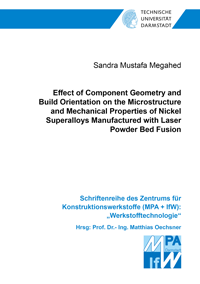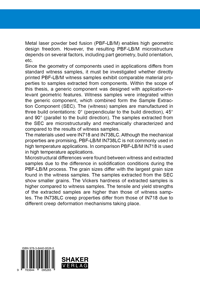
Shop : Details
Shop
Details
58,80 €ISBN 978-3-8440-9526-5Paperback176 Seiten106 Abbildungen240 g21 x 14,8 cmEnglischDissertation
Juni 2024
Sandra Mustafa Megahed
Effect of Component Geometry and Build Orientation on the Microstructure and Mechanical Properties of Nickel Superalloys Manufactured with Laser Powder Bed Fusion
Metal laser powder bed fusion (PBF-LB/M) enables high geometric design freedom. However, the resulting PBF-LB/M microstructure depends on several factors, including part geometry, build orientation, etc.
Since the geometry of components used in applications differs from standard witness samples, it must be investigated whether directly printed PBF-LB/M witness samples exhibit comparable material properties to samples extracted from components. Within the scope of this thesis, a generic component was designed with application-relevant geometric features. Witness samples were integrated within the generic component, which combined form the Sample Extraction Component (SEC). The (witness) samples are manufactured in three build orientations: 0° (perpendicular to the build direction), 45° and 90° (parallel to the build direction). The samples extracted from the SEC are microstructurally and mechanically characterized and compared to the results of witness samples.
The materials used were IN718 and IN738LC. Although the mechanical properties are promising, PBF-LB/M IN738LC is not commonly used in high temperature applications. In comparison PBF-LB/M IN718 is used in high temperature applications.
Microstructural differences were found between witness and extracted samples due to the difference in solidification conditions during the PBF-LB/M process. The grain sizes differ with the largest grain size found in the witness samples. The samples extracted from the SEC show smaller grains. The Vickers hardness of extracted samples is higher compared to witness samples. The tensile and yield strengths of the extracted samples are higher than those of witness samples. The IN738LC creep properties differ from those of IN718 due to different creep deformation mechanisms taking place
Since the geometry of components used in applications differs from standard witness samples, it must be investigated whether directly printed PBF-LB/M witness samples exhibit comparable material properties to samples extracted from components. Within the scope of this thesis, a generic component was designed with application-relevant geometric features. Witness samples were integrated within the generic component, which combined form the Sample Extraction Component (SEC). The (witness) samples are manufactured in three build orientations: 0° (perpendicular to the build direction), 45° and 90° (parallel to the build direction). The samples extracted from the SEC are microstructurally and mechanically characterized and compared to the results of witness samples.
The materials used were IN718 and IN738LC. Although the mechanical properties are promising, PBF-LB/M IN738LC is not commonly used in high temperature applications. In comparison PBF-LB/M IN718 is used in high temperature applications.
Microstructural differences were found between witness and extracted samples due to the difference in solidification conditions during the PBF-LB/M process. The grain sizes differ with the largest grain size found in the witness samples. The samples extracted from the SEC show smaller grains. The Vickers hardness of extracted samples is higher compared to witness samples. The tensile and yield strengths of the extracted samples are higher than those of witness samples. The IN738LC creep properties differ from those of IN718 due to different creep deformation mechanisms taking place
Schlagwörter: Laser Powder Bed Fusion; IN718; IN738LC; Creep; Microstructure
Schriftenreihe des Zentrums für Konstruktionswerkstoffe (MPA + IfW): "Werkstofftechnologie"
Herausgegeben von Prof. Dr.-Ing. Matthias Oechsner, Darmstadt
Export bibliographischer Daten
Shaker Verlag GmbHAm Langen Graben 15a52353 Düren
Mo. - Do. 8:00 Uhr bis 16:00 UhrFr. 8:00 Uhr bis 15:00 Uhr
Kontaktieren Sie uns. Wir helfen Ihnen gerne weiter.



